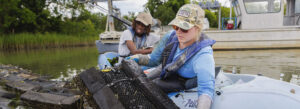VASG Fellow Aims to 'Elevate the Skate'
“Why clearnose skates? Why do we care about this species?”
It’s a question that Lindsey Nelson gets a lot about her master’s research on the clearnose skate. They’re some of the most abundant of the flat, cartilaginous fishes, and they can be found from colder New Jersey waters all the way to warmer Florida coasts, and in the Gulf of Mexico. Nelson studied how clearnose skates varied across different parts of the East Coast and in the Gulf.
“That’s a wide range of temperatures and salinities. It’s interesting to see one species living in such a broad environment,” Nelson, a graduate student at the Virginia Institute of Marine Science, said. “How does that environment affect their population connectivity, or their ecological role?”
Nelson combined two different approaches to look for differences between clearnose skates in different regions: examining their body structure and examining their genetic differences.
Spot the difference: lumps, fins, and genes
Nelson compared x-rays of 124 clearnose skates in the Northeast, Southeast, and Gulf to look for variations as part of her Virginia Sea Grant fellowship. She also measured their overall size, shape, and the distance between different parts of their skeleton. Hard parts of the fish, like their fin rays and teeth, are slow to change within a species, but Nelson found that clearnose skates in the Gulf had a different number of pectoral fin rays compared to skates along the East Coast.
But skates that look alike aren’t necessarily closely related. Jan McDowell, a research associate professor at VIMS and Nelson’s advisor, said that “cryptic species” are common in sharks, rays, and skates.
“They might look alike, and it turns out when you look closer at the genetics, you’re maybe looking at a couple species that appear to be the same species, or multiple populations,” McDowell said. “Lindsey confirmed that clearnose skates in the Gulf of Mexico are a very different population than clearnose skates along the U.S. East Coast.”
To tease out the finer variations, Nelson looked at genetic SNPs, or “snips” in genes — single nucleotide polymorphisms that are small genetic differences between individual skates. Each of these small differences, taken together, act like a “fingerprint” to distinguish skates from one another. Overall, these fingerprints can point to regional populations of clearnose skates that are genetically distinct from one another.
Researcher like McDowell want to know, “What is enough structure, enough genetic data to say you should definitely manage these things differently, or what’s the best precautionary measure?”
“They might look alike, and it turns out when you look closer at the genetics, you’re maybe looking at a couple species that appear to be the same species, or multiple populations,” McDowell said.
Shoppers likely won’t find skates in U.S. grocery stores or restaurants, because most that are caught are used as bait for lobster pots or exported to Europe or Asia.
The overlooked elasmobranch
Right now, clearnose skates are managed in the Northeast in a group with six other skates. Clearnose skates aren’t managed in the Southeast or in the Gulf. On the East Coast and West Coast, skates are the largest elasmobranch fishery by volume, according to Sonja Fordham, founder of Shark Advocates International. But shoppers likely won’t find skates in U.S. grocery stores or restaurants, because most that are caught are used as bait for lobster pots or exported to Europe or Asia, where skate wings are considered a delicacy.
Even though skates aren’t often targeted for fishing, they can be caught as bycatch during other types of commercial fishing. Like sharks and rays, skates produce few offspring and reproduce slowly — so if many are caught from fishing, it can take populations longer to recover. But unlike many shark species, there is relatively little management for skates, Fordham said.
“Clearnose is one of the skates that doesn’t seem to be of concern, but that can change quickly,” Fordham said.
The barndoor skate, a larger skate protected in the Northeast, has begun to recover after their populations dropped in the early 2000s. For the thorny skate, which has been “flatlining for decades,” population levels still haven’t recovered, Fordham said. Clearnose skates are found all along the East Coast and in the Gulf, but only managed by the New England Fisheries Management Council.
“Lindsey’s research would be particularly useful if there starts to be a problem,” Fordham said. “Problems and new markets can spring up rather quickly, for all types of seafood products. You just don’t know what the next delicacy will be. You try to have management in place so things don’t get out of control.”
Takeaways:
- Lindsey Nelson identified differences and similarities in clearnose skate genetics and body structure for different regions along the East Coast and in the Gulf of Mexico.
- Even though skates aren’t often targeted for fishing, they can be caught as bycatch during other types of commercial fishing. It can take populations a long time to recover from overfishing.
- Nelson’s research confirmed that clearnose skates in the Gulf of Mexico are a very different population than clearnose skates along the U.S. East Coast.
Photos and Video by Mallory Huxford | Virginia Sea Grant
Video produced by Aileen Devlin | Virginia Sea GrantPublished July 9, 2021.
“That’s a wide range of temperatures and salinities. It’s interesting to see one species living in such a broad environment,” Nelson said.





